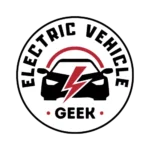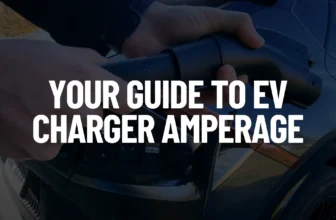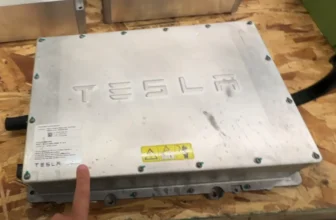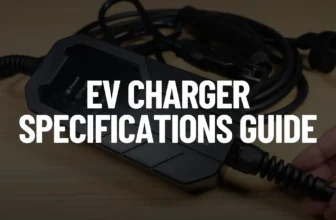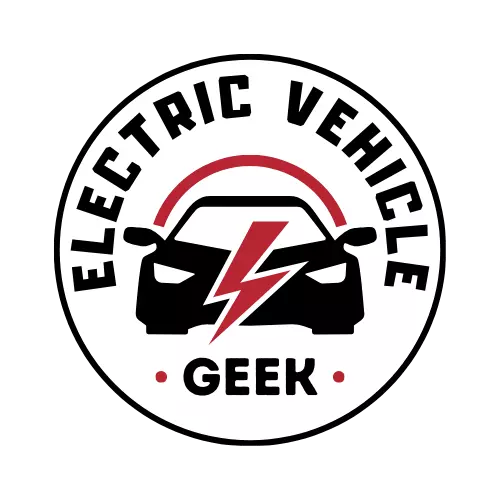As the automotive landscape evolves with the increasing popularity of electric vehicles (EVs), choosing the suitable home car charger has never been more critical. With over 80% of EV charging at home, developing a well-thought-out charging plan becomes imperative.
This comprehensive guide aims to delve into the key considerations that will empower you to select the optimal home car charger tailored to your needs.
Check out our Comprehensive Comparison of EV Charger Warranty and Customer Support
What is the type of EV – Battery-electric or plug-in hybrid?
Understanding the nature of your electric vehicle is the first step in choosing an appropriate home car charger. Battery-electric vehicles (BEVs) have larger battery capacities, necessitating more powerful chargers.
Level 2 chargers are recommended for faster home charging, catering to the energy demands of BEVs. On the other hand, plug-in hybrid electric vehicles (PHEVs) generally have smaller batteries.
While Level 1 chargers may be sufficient, opting for Level 2 chargers ensures faster charging, particularly for PHEV owners with longer daily commutes.
Level 1 or Level 2 Chargers
Level 1 chargers, designed for typical home outlets (230V), are ideal for overnight charging. However, they are comparatively slower, providing a range of 3 to 5 miles per hour.
Level 2 chargers require a 240-volts outlet for electric car chargers and offer faster charging speeds, delivering a range of 12 to 80 miles per hour. The decision between Level 1 and Level 2 should be based on your specific charging requirements, considering the type of EV you own and your daily commuting patterns.
The choice between Level 1 and Level 2 chargers ultimately depends on your EV’s specifics and charging requirements. Level 1 chargers are suitable for most plug-in hybrid drivers, providing adequate charging for daily use. However, their slower charging speeds may not be ideal for all-electric commuters relying solely on electric power.
Level 2 chargers, recommended for all-electric vehicle drivers, offer faster charging and are ideal for plug-in hybrid drivers with daily commutes exceeding 50 miles. Consider your individual needs, commute frequency, and the charging demands of your EV to make an informed decision.
Installation Location
The location of your home car charger installation is crucial and requires careful consideration. Weather-resistant chargers with a high Ingress Protection (IP) rating are essential for outdoor installations.
These chargers must withstand the elements, including rain, wind, and temperature fluctuations. Indoor installations offer more flexibility but require proper ventilation and adherence to safety protocols. Understanding the environmental conditions of the installation site is paramount in ensuring the longevity and effectiveness of your home car charger.
Three-Phase versus Single-Phase EV Charger
Depending on your power source, you might have a single-phase or three-phase power source; electric vehicles (EVs) can be charged using single- or three-phase power outlets. The key distinction lies in how power flows:
Single-phase
- Power flows through a single conductor.
- Operates at 120 to 240 volts, delivering up to 7.7 kW, similar to standard household outlets.
Three-phase
- Power flows through three conductors.
- Operates at higher output voltage levels, typically around 400 or higher.
- It is more efficient for vehicles with larger battery capacities.
- Provides 11 to 22 kWh of energy per hour, compared to 3.7 to 7.4 kWh from a single-phase charger.
- Three-phase cables can be used on single-phase, but the reverse is impossible.
EV Charger Power Supply Source
Another factor to consider when selecting an EV charger is the power source of your EV Charger and whether the EV Charger is designed and configured to match your power source to ensure efficient and safe operation. Below are some factors to consider:
Residential Locations
- Power supplies should adhere to class B electromagnetic emissions limits for homes to prevent interference with other devices.
- Level 1 and Level 2 EVSEs may be installed at residential locations, necessitating compliance with class B limits.
- Dedicated hardwired installations are recommended for Level 2 chargers in residential settings, placing the connection closer to the utility source.
- Residential installations fall under over-voltage category II (OVC II), and power supplies should be designed accordingly.
Non-Residential Locations
- Non-residential locations generally need to meet the less stringent Class A limits for electromagnetic emissions.
- The use of smaller filters can save space in non-residential installations.
Outdoor Installations
- Level 2 and Level 3 EVSEs outdoors require power supplies with a wide temperature range.
- Temperature ranges of -30 °C to 70°C, as found in the VGS-100D, ensure safe operation in varying weather conditions.
- Over-temperature protection adds an extra layer of security in unpredictable climates.
- Outdoor installations are exposed to dust and debris; protecting the power supply with conformal coating or full encapsulation safeguards against environmental elements.
Level 3 EVSE Power Supply
- Level 3 EVSEs often operate up to 480 V at three-phase voltages to achieve the highest output power.
- Auxiliary power supplies for Level 3 applications must be rated up to a 305 V AC input to handle the 277 V AC single-phase line voltages.
- These installations, categorized as over-voltage category III (OVC III), require increased surge protection and specific design considerations.
Power Output and Vehicle Compatibility
Assessing your EV’s maximum charging capacity is imperative to ensure efficient charging. Selecting a home car charger that matches or exceeds this capacity is essential for optimizing charging times. Being mindful of the power output and compatibility with your vehicle ensures a seamless and practical charging experience.

Rapid and Ultra-Rapid Chargers
- Rapid charging at 50 kW DC on specific EV connector types.
- AC is charging at 43 kW on a designated connector type.
- Ultra-rapid charging surpassing 100 kW DC on specific EV connector types.
Fast Chargers
- Fast charging options include 7 kW on one of three EV connector types.
- Accelerated 22 kW charging on a selection of three connector types.
- Specialized 11 kW fast charging is available on the Tesla Destination network.
Slow Chargers
- Slow charging, ranging from 3 kW to 6 kW, on four distinct EV connector types.
- Charging units provide flexibility with both untethered and tethered cable options.
- Encompasses mains charging capabilities and compatibility with specialist chargers.
EV Charging Connector Types
For compatibility purposes, you should match the EV charger plug connector with your EV power inlet; EV charger connectors can be classified into AC and DC.
AC Connectors
- UK 3-pin (BS 1363)
- Industrial Commando (IEC 60309)
- Type 1 (SAE J1772)
- Type 2 (Mennekes, IEC 62196)
DC Connectors
- CHAdeMO (Japanese JEVS)
- CCS (Combined Charging System or ‘Combo’)
- Tesla’s proprietary supercharger connectors
Networked Vs Non-Networked EV Chargers
When researching the best Home EV chargers, you will come across networked vs. non-networked EV chargers. Based on the design’s physical look, the chargers might look the same, but one offers smart charging management features and tools such as security, pricing, and EV charging performance.
What is a Non-Networked EV Charging Station?
Non-networked EV chargers aka Stand-alone chargers, akin to advanced wall outlets, are perfect for home use or private fleets. They offer simplicity and affordability without network connections, resulting in lower upfront costs and a straightforward setup. Additionally, they provide privacy for charging data. However, they lack features such as payment processing and real-time updates, making them less suitable for public use.
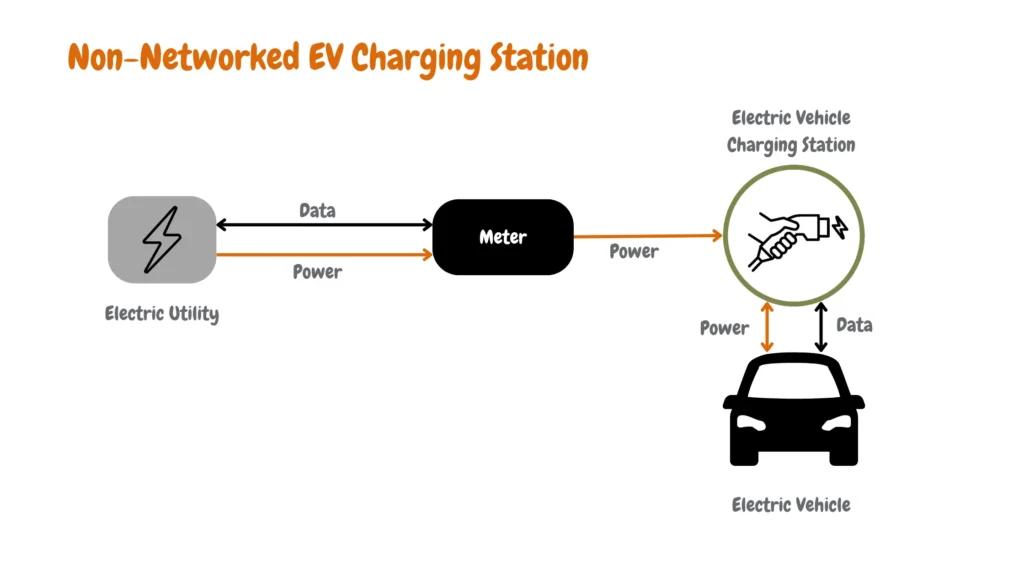
The infographic image above shows how a Non-Networked EV Charging Station transfers data and power between the electric vehicle, charger, meter, and electric utility.
What is a Networked EV Charging Station?
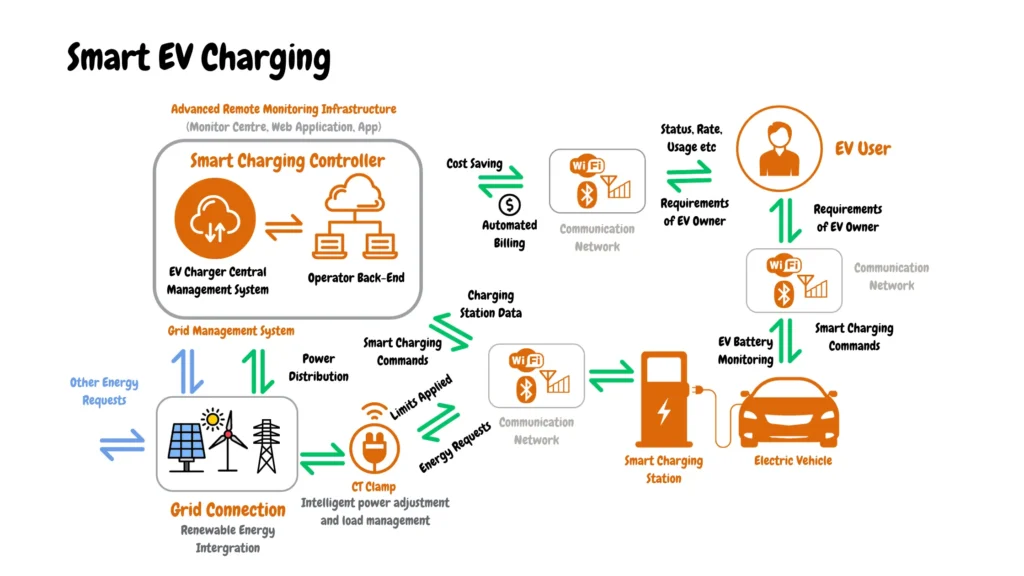
On the other hand, networked chargers also called smart EV chargers are connected to the internet, offering a range of features ideal for smart EV charging management. They enable convenient payment options, real-time updates on station availability, and insightful data tracking. While networked chargers provide enhanced functionality, they come with higher upfront costs, potential complexity in setup and management, and privacy considerations regarding data collection.
The infographic image below shows how a Networked EV Charging Station transfers data and power between the electric vehicle, charger, meter, electric utility, and other smart features such as smartphone, cell service or internet, cloud, network administrator, transaction processor, bank, and service center.
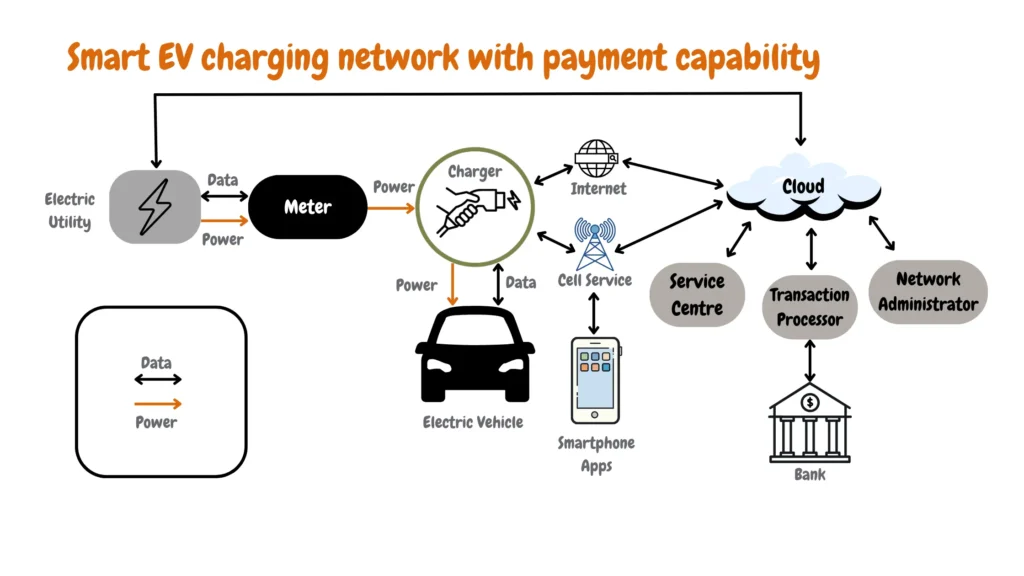
When deciding between the two, consider your charging needs.
Non-networked EV chargers may suffice for home use or small fleets due to their simplicity and affordability. However, homeowners with multiple electric vehicles, homeowners planning on using renewable energy to charge their electric vehicles, and smart geeks who need smart EV charging features will benefit more from the features of networked chargers, ensuring management tools, convenient access, and payment options for various users.
Another consideration concerning networked EV chargers is whether the EVCs comply with the Open Charge Point Protocol (OCPP). OCPP-compliant chargers and software are designed to function together regardless of manufacturer.
Tethered vs. Untethered Chargers
The choice between tethered and untethered chargers revolves around convenience and flexibility. Tethered chargers feature a fixed charging cable, providing convenience but limiting flexibility, especially when dealing with multiple EVs that may have different connector types.
Conversely, untethered chargers offer flexibility with different cables, making them ideal for households with multiple EVs or those anticipating future upgrades.
- Cost: Tethered chargers may be more cost-effective because they are all-in-one. Untethered chargers can be more budget-friendly because you only need to buy the cable you need.
- Installation: Tethered chargers are simple because they come with pre-attached cables. Untethered chargers are more flexible and adaptable.
- Malfunction: Tethered chargers are less likely to malfunction than untethered chargers.
EV Charger Cable Length
When selecting an EV Charger, consider its cable length and the optimal balance between convenience and practicality. Typically ranging from 4 to 10 meters, a cable length of around 7.5 meters is often recommended, striking a harmonious compromise between user-friendliness and easy storage.
Choosing a length that seamlessly spans the distance from your EV charger to your vehicle is crucial. While longer cables provide extended reach, they also come with added weight, bulk, and cost. Unless you specifically require the extra length, a shorter cable is usually sufficient for efficient charging without unnecessary complications.
Additional Features
Incorporating advanced features can significantly enhance the overall charging experience.
Load Balancing
Load balancing is an essential aspect of electrical safety and efficiency. If you need power management capabilities, especially if you plan on using renewable energy, opt for an EV Charger to adjust the power output based on household electricity usage. This not only prevents overloading but also contributes to energy savings.
Bidirectional EV Charger
If you own an electric vehicle that supports bidirectional EV charging, we highly recommend considering a bidirectional charger, a revolutionary technology that empowers electric vehicles (EVs) to receive power and contribute energy back to your home or the electricity grid.
Unlike traditional charging systems that only facilitate energy flow from a power source to the vehicle’s battery, bidirectional chargers offer a dynamic two-way interaction, providing greater flexibility and sustainability.
Mobile App Compatibility
Another valuable feature is mobile app compatibility, allowing remote monitoring and control of charging sessions. This capability enables users to schedule charging during off-peak hours, optimizing cost efficiency and contributing to a more sustainable charging routine.
For EV owners who want to use third-party applications for remote monitoring and EV Charging management, consider opting for an EV charger that supports Open Charge Point Protocol (OCPP). The Open Charge Point Protocol (OCPP) is a communications standard for the electric vehicle (EV) charging industry. It’s an open-source protocol that enables communication and management of EV charging infrastructure.
Here’s a guide to ensure your EV charger’s mobile app meets your needs:
Energy Management
Opt for a mobile app that integrates energy management features. This ensures dynamic power distribution, considering available power, charging demand, and electricity prices. Such optimization enhances operational efficiency and helps manage charging costs in alignment with safety regulations.
Payment Processing
A versatile mobile app should support various payment options, including special pricing for residents or employees, network membership rewards, and off-peak pricing. Seamless payment processing adds convenience to the user experience.
Hardware Management
Prioritize a mobile app that enables quick detection and resolution of network issues and charger faults. Look for features such as notifications, remote troubleshooting options, and direct links to customer support. These elements are vital for homeowners with a fleet of electric vehicles and dual EV Chargers.
Fleet Operations and User Access
For homeowners with a fleet of electric vehicles, a mobile app should provide a centralized platform for monitoring individual cars, communicating with drivers, and controlling access to EV chargers. The app should support user authentication and customizable permissions to streamline fleet operations.
Software Updates and Phone Compatibility
Check if the mobile app provides regular software updates to ensure compatibility with the latest features and advancements. Confirm that the app is compatible with your smartphone, ensuring a seamless connection and optimal user experience.
Conclusion and Recommendations
Selecting a suitable home car charger is a multifaceted decision that requires careful consideration of various factors. The type of EV, range, commute frequency, and charging flexibility all play pivotal roles in determining the most suitable charging solution for your lifestyle.
While Level 1 chargers may suffice for some users, Level 2 chargers are often recommended for efficient charging, particularly for all-electric vehicles with higher power demands.
To make an informed decision, thoroughly evaluate your needs and charging habits. Doing so ensures that your chosen home car charger aligns seamlessly with your lifestyle, providing a reliable and efficient charging solution for your electric vehicle.

James Ndungu is a certified EV charger installer with over five years of experience in EVSE selection, permitting, and installation. He holds advanced credentials, including certification from the Electric Vehicle Infrastructure Training Program (EVITP) and specialized training in EV charging equipment and installation, as well as diplomas in EV Technology and Engineering Fundamentals of EVs. Since 2021, James has tested dozens of EV chargers and accessories, sharing expert insights into the latest EV charging technologies.
